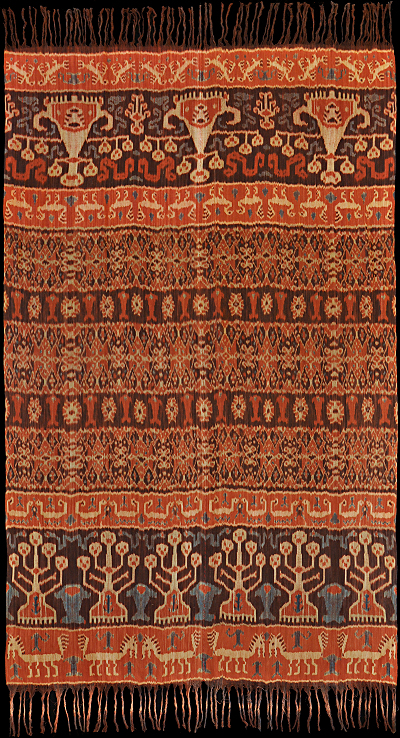| |
 
 | | | |
222 Sumba, East Sumba
Hinggi (men's blanket)  
| | Locale: | Kanatang | | Period: | 1930 | | Yarn: | Cotton, hand-spun, extremely fine, double-ply | | Technique: | Warp ikat | | Panels: | 2 | | Size: | 148 x 248 cm (4' 10" x 8' 1") LW: 1.68 | | Weight: | 925 g (32.6 oz), 252 g/m2 (0.83 oz/ft2) | | Design: | Hinggi with extremely rare construction called hondu kihhil wallah, which is both axially and longitudinally asymmetric. In deviation from the East-Sumbanese standard construction, top and bottom have similar but markedly different motifs. One side shows six andung, skull trees bordered by bands with cockatoos - the hallmark of Kanatang nobility - and horses. Note that there are three skull trees per panel in the upper ikated band, not an even number, and three horses in the bottom band, meaning that the panels could not be made with a longitudinal repeat, the wallah factor. The combination of these two complications is very rare. Patola midfield, broken into three sections by two bands with fishes and unknown motif. Various small animals, mainly snakes, are distributed as fillers. | | Comment: | Extremely rare Sumba textile that lacks the usual axial symmetry - and hence requires twice as many ties as a normal hinggi, about 10,000 in this case. The 'pagi sore' approach, with different top and bottom, was en vogue for a while in the late 1950s and 1960s, probably to please the demanding foreign market. Examples from the early 20th C. have been rumoured to exist, but before this piece was found we did not see another. If there are other such hinggi extant they have not been published. Note the classic division of the field in eleven bands. Absence of a kabakil, a border woven across the warp, indicates that the cloth was never intended to be worn. From old Dutch collection. | | Background: | Chapters on Sumba and East Sumba. | | Exhibited: | Hong Kong University Museum and Art Gallery, 2017. | | Published: | Ikat Textiles of the Indonesian Archipelago, 2018.
Ikat from Timor and its Outer Islands, 2022.
Noble Virtuosity: Hidden Asymmetry in Ikat from Sumba, 2024. | | Compare: | 319 | | Sources: | The existence of early cloths of this type was reported to one researcher, the name of the type given as searah, 'one way'. (Jill Forshee, pers. comm., 2016.) One example of an old hinggi with different top and bottom is in the Tropenmuseum collection, TM-1772-1101, dated 'pre 1940'. That hinggi is of a different type, where one half is done in multiple colours, the other just in white on indigo. | | |

©Peter ten Hoopen, 2024
All rights reserved.
|
|


